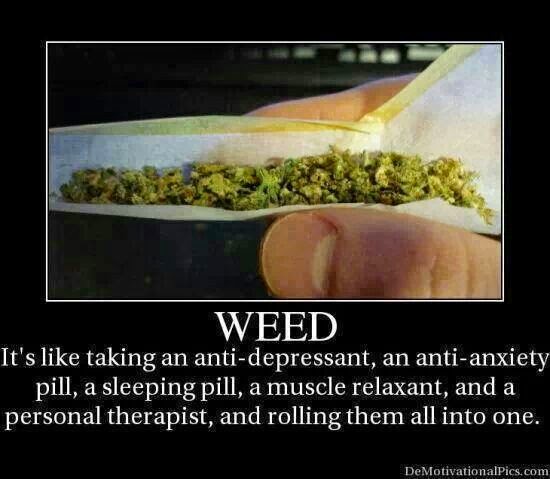Now that we
have determined what exactly medical marijuana is, what it does, and how it
could be possible to relate it to psychological disorders, I would like to
introduce an article proving how cannabinoids affect behavior and the
neurotransmitters of the brain. Cristina Arévalo, Rosario De Miguel, and Rafael
Hernández-Tristán published an article, titled Cannabinoid Effects on Anxiety-Related Behaviors and Hypothalamic
Neurotransmitters, in 2001. Like most psychological studies, this
experiment was tested on rats. They treated the animals with CP 55,940 (a cannabinoid
agonist) and SR 141716A (a cannabinoid antagonist). An agonist is defined as a
chemical substance capable of activating a receptor to induce a full or partial
pharmacological response. On the other hand, an antagonist is defined as a drug
that counteracts the effects of another drug. The chemical structure of ∆9-tetrahydrocannabinol
compared to both, CP 55,940 and SR 141716A, can be dictated below:
Image courtesy of: http://www.kindgreenbuds.com/marijuana-articles/cannabis-science/
- “CP 55940 is a cannabinoid which mimics the effects of naturally occurring THC (one of the psychoactive compounds found in marijuana). It is currently used to study the endocannabinoid system. CP 55940 is considered a full agonist at both CB1 and CB2 receptors. Application of [3H] CP 55940 can be found in: binding to cannabinoid-1 receptors associated with schizophrenia and cannabis use in neuroscience, inhibition by phthalate esters in vitro in neurochemistry, actions of benzophenanthridine alkaloids, piperonyl butoxide and (S)-methoprene in pharmacology, etc."
- “SR141716A is a selective antagonist for CB1 cannabinoid receptors. It has been used as an anorectic anti-obesity drug. It is an inverse agonist for the cannabinoid receptor CB1. Its main avenue of effect is reduction in appetite; it has also been studied in smoking cessation and short-term memory improvement.”
Arévalo, De
Miguel, and Hernández-Tristán used both of these drug treatments on rats,
individually and simultaneously, to test the effects on brain stimulation
through hypothalamic neurotransmitters. They compare CP 55,940 to the active
ingredients of ∆9-THC and the similar affects of both. THC is said to be the leading cannabinoid
from marijuana that can cause psychoactive effects on the brain. Evidentially,
the research of this study determined that “CP 55,940 increased hypothalamic
dopamine and serotonin levels” which could be “involved in the activation of
the hypothalamic-pituitary-adrenal axis” in the brain, particular to
cannabinoids (Arévalo, et al. 123). SR
141716A “induced a reduction in exploratory parameters and an increase in
anxiety-like responses” (123). This article proves that all three examples of
cannabinoids given, cause psychoactive effects and can lead to a change in
behavior and cause anxiety. While determining these factors, the researchers
studied numerous behavioral characteristics of the rats while providing them
with the treatments of drug(s).
Image courtesy of: http://www.pinterest.com/pin/13792342582700018/
The reason
why I chose this article to talk about is because of its’ relation to THC. As
noted before, THC causes psychoactive effects; so why would we turn to
marijuana for treating psychological disorders if it can cause anxiety? Well,
medical cannabis has specific ratios of cannabinoids in order to treat specific
disorders. Marijuana high in THC content is not recommended for people
suffering from psychological disorders because it can cause anxiety and motor
inhibition. However, cannabinoids like CBD, CBC, CBN, CBG and THCV all exhibit
crucial roles as anti-psychotics. These cannabinoids would have higher content
ratios if being patients are being treated for psychological purposes.
Image courtesy of: http://www.pinterest.com/pin/13792342583676064/
Sources:
http://ac.els-cdn.com/S0091305701005780/1-s2.0-S0091305701005780-main.pdf?_tid=97e3eac8-4f1e-11e4-93d0-00000aacb35f&acdnat=1412795534_f9189ed7405c60a1fe57a2d078254b05



I thought this was a little difficult to read and understand even though you did define an agonist and an antagonist. The article does look like it could be interesting in the effects of THC on the brain and how that can lead to psychoactive effects such as anxiety. It might be a little easier for the public to understand if you broke it down from all the scientific jargon. However, I do get that most of it is scientific research and properties so it may not be easy to explain it without specific science language.
ReplyDeleteAlthough I thought you found an amazing and informative article, I do agree that it was a bit difficult to read. But I did like how you were able to simplify it at times. I remember back when you and Chris presented your public projects, I wondered whether research was being done on medical marijuana and how it can be modified or manipulated to be disease-specific or disorder-specific; it was really interesting to learn that cannabis has different ratios of cannabinoids used in treatment with specificity for different disorders.
ReplyDelete